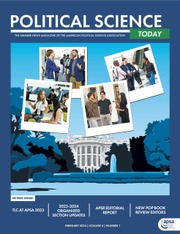This report marks the sixth and final year of the Florida team as the editors of Perspectives on Politics. This year brought a return to something resembling normalcy following the acute period of the COVID-19 Pandemic. Rather than concentrating exclusively on our practice in the last year or the future development of the journal, we will use this report as an opportunity to reflect on the development of the journal over the last six years.
Our most important goal when we started was to maintain Perspectives on Politics as an outlet that is open to publishing a wide variety of cutting-edge political science irrespective of its methods, ontology, or epistemology. Given the pluralism across these dimensions in our discipline, maintaining a high visibility and high impact journal that was open to a wide variety of approaches to studying politics was essential to the preservation of that disciplinary pluralism. Another important aspect of the journal that we have tried to maintain and expand is its topicality. We have worked hard during our editorship to publish work that speaks to the burning issues of the day.
We have also tried to preserve the journal’s tradition of pushing authors to write in natural rather than specialized language so that all published work was accessible to the widest possible audience. The intention here was to attempt to reach audiences beyond professionals in the discipline and to make it possible for colleagues from radically different research traditions to read each other’s work. We also pledged to internationalize the journal, modernize its practices, to reconsider the level of “desk” rejects, and maintain the high quality of the journal as the book review of record for the discipline. We were successful in achieving the vast majority of these objectives, even if we could not achieve them all, as we explain below. Finally, we have been committed to publishing authors who reflected the diversity of political scientists in terms of race, ethnicity, and gender.
THEMATICS
A hallmark of Perspectives during the Florida period was that every issue either contained a special section or was a special issue devoted to important themes in contemporary politics. This was already a frequent feature of the journal, but it became a defining one under our stewardship. Every one of these special features spanned subfields, with many including selections from all four major subfields. Our reasons for choosing this strategy had two important rationales—topicality and impact. On the former, we grouped together articles that addressed many hot button issues, like democratic backsliding, the politics of the pandemic, immigration, or the Black Lives Matter movement. This was highly congruent with our desire to demonstrate that a journal could be open to all corners of the discipline while being impactful and maintaining the highest scholarly standards. Topicality drives many research agendas, and by grouping articles on the current issues of the day we reasoned that this would be a good way to draw attention to the journal and to expose specialists to multiple articles of interest. We felt that colleagues with an interest in the subject would spend more time at the journal if it included a cluster of articles on a given topic.
We reasoned that thematic foci would help us to put the journal’s impact on a more stable path. We faced something of an impact crisis early in our tenure at the journal when a very highly cited article dropped out of the impact score. We thought that more balance in the sources of our citation was a better path to long term stability. This has proved to be true in the short run, as the journal has recovered and exceeded its earlier impact scores without relying too much on any one article (see the section on impact below). As impact factors lag publication by a couple of years, we will see if this pattern continues in the near future, and beyond, if our successors choose to emulate this strategy.
Another interesting aspect of our commitment to special sections and issues is how we assembled them. Many journals are approached by groups of scholars who propose special issues. While we were open to this, we required all items to go under individual review to ensure uniformly high-quality articles. Some prospective guest editors were reticent to do this, and consequently the yield from such procedures did not prove to be very successful. Conversely, four of our specials were the product of calls for papers – “Trump: Causes and Consequences” (two issues), “Celebrity and Politics,” “Pandemic Politics,” and “Black Lives Matter.” For “Celebrity” and “BLM” the initiative and lead was taken by two of our editorial board members—Samantha Majic and Chris Parker. For these two special issues, the editorial team took on the role of supporting cast.
Most of the other specials were organized by grouping together individual submissions and bundling them together by theme. This was possible because of our adoption of FirstView for accepted material (the journal had no online publication method previously), and the fact that the printed version of journals became less important relative to the web version over this time period. This made it possible for us to publish work online without putting it immediately into an issue, thereby allowing us to bundle thematically-linked submissions from over a longer period.
DIVERSITY ISSUES
As a team we worked hard to cultivate three kinds of diversity—methodological, gender, and race and ethnicity. The origins of Perspectives go back to the methods wars of the 1980s. Because the quantitative/qualitative divide that drove that conflict is less salient now than it was then, the journal is open to an even broader range of approaches. We still pride ourselves on being a go-to outlet for cutting edge qualitative work ranging from interpretive, ethnographic, comparative historical, region or country-specific, as well as political theory. And, increasingly, we find that work in these varieties is combined with quantitative techniques in mixed or multiple method designs. As the discipline has become more quantitative, we have published more statistical work both in Bayesian and frequentist varieties, and increasingly we see submissions using novel techniques of causal inference. The latter is by no means a requirement to publish in Perspectives as there are many ways to make credible inference. Finally, we have seen a large uptick in experimental work in the behavioral side of the discipline. This reflects changes in practice in the discipline, where list and conjoint experiments have become more common than any preference or requirement on our part. Irrespective of the approach of the authors, one thing that we strive for in all Perspectives articles is to make an interesting and timely substantive contribution to the discipline and to present it in a way that is accessible to a general audience.
We designed our external review policy to hopefully enhance the diversity of our authors both in terms of gender, race, and ethnicity. In our external reviews we strive for four reviewers, of whom at least two were female, as a way to promote gender balance in publication. It was impossible to duplicate this sort of representative diversity in the case of articles on LGBTQ+ issues. In order to ensure that submissions in this area faced no discrimination we always tried to find reviewers who, on the basis of their previously published work, would be knowledgeable and fair. With regard to submissions that concerned the politics of race and ethnicity, particularly when they concerned groups historically underrepresented in the discipline, we endeavored to find colleagues from those groups to review such submissions. Here again we strove to maintain a 50 percent quotient at minimum. With regard to race, ethnicity, and gender we were not always successful in getting our preferred mix of reviewers, often because potential reviewers already faced heavy service burdens, but on balance we were largely successful in doing so. As to whether the journal was successful in promoting the diversity of the discipline in these terms, we do not have the data to demonstrate its effectiveness. We leave it to our colleagues and history to make that assessment.
INTERNATIONALIZATION
APSA asked us to further internationalize the journal. We pursued this in several ways. First, we added the first editorial board members from outside the United States. And, among the American political scientists, we appointed several American-based colleagues who were born outside the United States. Second, whenever we could, we used the international political science community as reviewers—both for articles and in the book review section. Both of these signals had the effect of attracting more submissions from a broader range of countries. This year, for the first time, more corresponding authors on submissions came from outside the United States then from within. We continued to publish a good number of manuscripts from Europe, though mostly but not exclusively from the UK and Western Europe. We also published a number of manuscripts from Latin American authors, and a small number from East Asia and the Middle East. While we did receive a small number of submissions from South Asia, Southeast Asia, and Africa, none made it through the review process. However, we hope it is just a question of time before the journal receives greater numbers of submissions from these regions, with publications likely to follow.
TECHNICAL ENHANCEMENTS
We pursued a number of measures to modernize the journal. We increased the presence of the journal on the web substantially. First, we created a Dataverse site to post replication data (https://dataverse.harvard.edu/dataverse/perspectives). Second, we created a Facebook page (https://www.facebook.com/PoPpublicsphere). Jennifer Boylan also actively curated the existing Twitter page. As a result of her efforts, the number of users has grown steadily from several hundred to over seven thousand (https://twitter.com/PoPpublicsphere).
As mentioned earlier, we also moved to publish accepted work on FirstView. We also supported Cambridge and APSA in their attempts to move the journal in the direction of greater Open-Access. The journal presently has hybrid status combining both open-access and paywalled content. It will be difficult to move the journal to fully Open-Access as the book review is not covered by existing Read-and-Publish agreements between Cambridge and large research universities and consortia. However, we were able to streamline book review submissions by moving them entirely to the Editorial Manager system, per APSA’s request, and to create efficiencies in obtaining copyright permissions from authors through adopting the Ironclad system.
Finally, on APSA’s initiative, the number of print copies of any issue has been substantially reduced. Most members now receive notification of publication via email without receiving a paper copy. This both yielded substantial savings, particularly on postage costs, and was the more environmentally responsible option. It made perfect sense given that the vast majority of political scientists read journal articles as PDFs, either online or printed locally. This has allowed us to expand the number of articles that we have been able to publish in each issue. In 2019 each issue of Perspectives was capped at 296 pages, with 148 for articles and reflections and 148 for book reviews. Since then it has grown steadily to 384 pages, with the size of the book review remaining constant.
SUBMISSIONS AND PROCESSING
The total number of submissions in 2022 fell for the second year in a row (see table 1). The highpoint came in 2020 when we issued two calls for papers (Pandemic Politics and Black Lives Matter). We suspect that the drop-off in 2022 from 2021 is also in part a lagged effect of the pandemic on productivity. Our suspicion, based on anecdotal evidence, is that the launching of new projects, especially those requiring fieldwork or polling were postponed. However, the level of submissions is still appreciably higher than pre-pandemic levels.
Table 1: Manuscript Submissions per Year
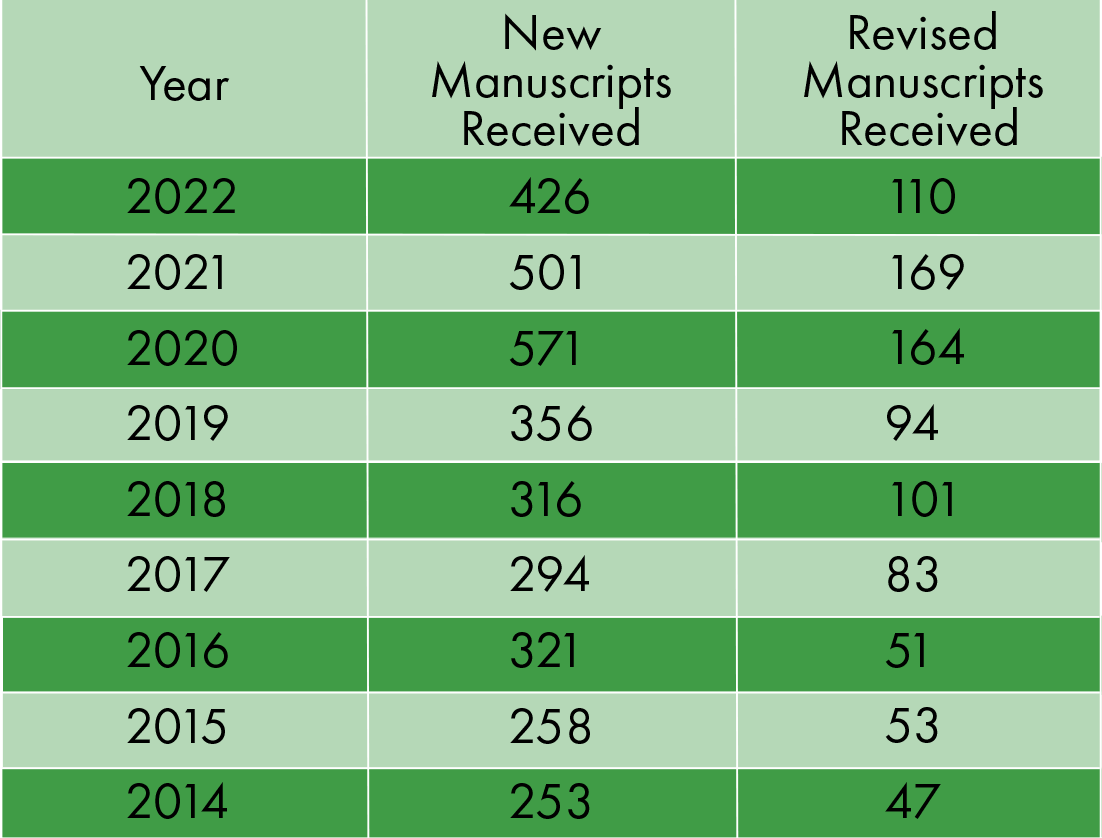
Table 2 shows that 2022 was the first year that a majority of the manuscripts submitted to the journal had a corresponding author based outside the United States. One could say that Perspectives has ceased to be only an American journal, but now functions as a journal of international political science with a global profile.
Table 2: Number of Manuscripts Received Based on the Location of the Corresponding Author (based on available data)

PROCESSING OF SUBMISSIONS
In table 3 we show the average number of days that it takes to come to a first decision on all submissions in a given year. We maintain a quick average turnaround time of just over a month. However, this figure requires further unpacking. Most manuscripts that we decline without an external review usually get that decision within two weeks of submission. Submissions that go out for review take considerably longer, six weeks at a minimum.
Table 3: Average Number of Days in Review Process

EDITORIAL DECISIONS
Table 4 presents data on editorial decisions on the first round of review in 2022. The number of manuscripts DNER’d (declined without external review) increased slightly from 58.5% in 2021 to 61.4%. Of the 156 submissions that went out for external review (the same as in 2020), 36 submissions (23%) received revise and resubmit decisions. 28 of these were Major Revisions, 8 were Minor Revisions, and 2 Reflections pieces received Conditional Accept decisions.
Table 4: First Round Editorial Decisions 2022
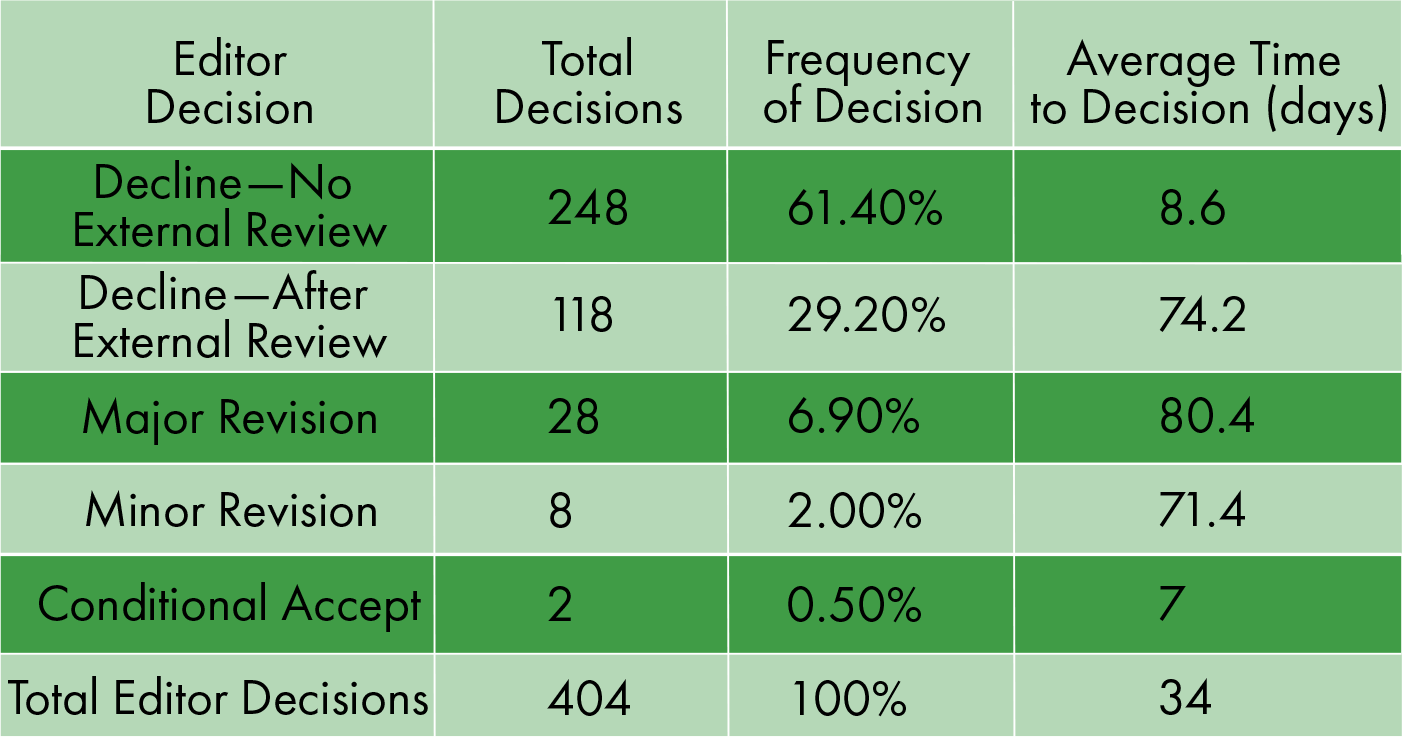
Table 5 compares decisions taken in 2022 to the previous eight years. We were more stringent in our decision-making this year because we wanted to avoid leaving too much material in the queue for our successors. While the rate of DNERs showed only a slight uptick, the decline after external review rate was the highest posted in the recent past.
Table 5: Outcome of First Round of the Review Process, 2014-22 (percentage)

Our inability to reduce the number of DNERs further than we did is a function of the vagaries of publication and the special role of Perspectives in the discipline. As with all journals, a high percentage of DNERs were due to quality issues. These were divided into a fair number of submissions about politics more broadly rather than academic political science, as well as promising submissions that we describe as “prematurely submitted.” Such papers often have good or promising ideas but need further work or refinement before they stand a chance of passing external review. We also continue to reject a large number of papers due to lack of fit. These are often quality research papers but are too narrowly cast to fit within the journal’s clearly stated mission. We avoided the temptation to send premature submissions or bad fit papers out to reviewers in favor of desk rejecting them in house. We made this choice to maintain our credibility with our reviewer pool and to avoid wasting the time of the weary ranks of our overworked and generous colleagues.
JOURNAL IMPACT
Figure 1 (next page) displays the journal’s impact scores for the last eleven years. The Clarivate Journal Citation Reports both include two-year and five-year impact factors. The two-year impact factor (JIF2) continues to show robust recovery from its substantial decline in 2017. The two-year JIF jumped from 3.776 (2020) to 4.847 (2021) and the five-year JIF from 4.064 (2020) to 4.699 (2021). This moved Perspectives from the 36th to the 14th highest ranked journal in the discipline. These are the highest impact scores in the history of the journal.

Figure 1: Journal Impact, 2010-2021Footnote 1
Perspectives on Politics is also highly ranked in the discipline according to the latest Google H5-index (see table 6 below). In the past year the journal moved from 18th to 14th place. The H5-Index score is the highest number of articles that have received that many cites in the last five years. That means we have 41 articles which have received 41 citations in the last half decade (2017-2021). The H5-median of 63 is the median number of citations for the 41 pieces included in our H5-index score.
Table 6: The Google H-5 Rankings, Political Science
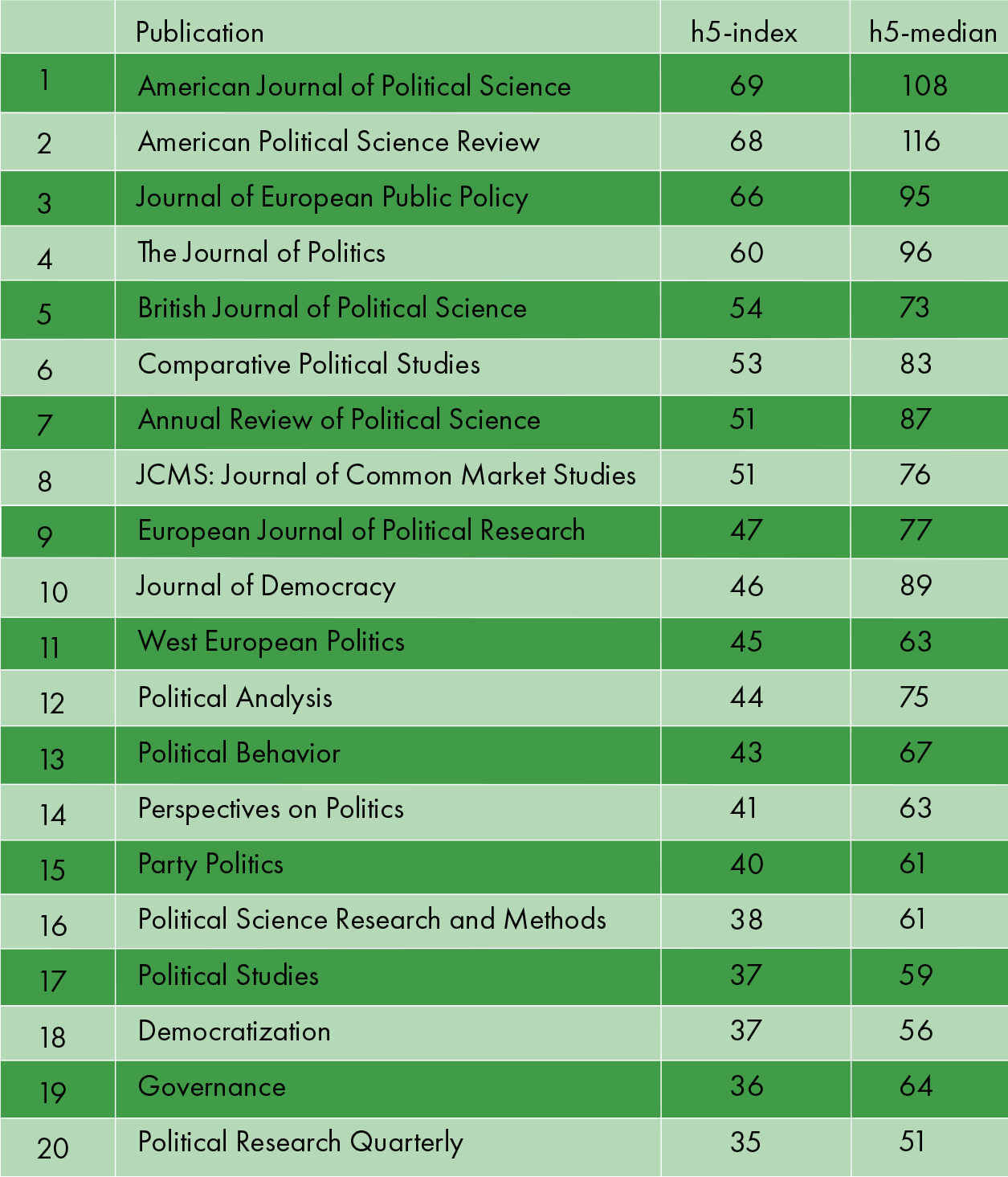
As the book review of record for the American Political Science Association, Perspectives on Politics fulfills a unique mission. Whereas other journals may cover a handful of specialized volumes, our remit is to comprehensively review cutting-edge scholarly books across the discipline. The number and quality of these reviews are crucial for creating an inclusive discursive community focused on important ideas, but also for issues of professional visibility, and for tenure and promotion decisions. For these reasons, the Book Review Section is a tremendous responsibility, as well as an enormous amount of work. At the University of Florida, we have tried to embrace this challenge with the seriousness of purpose that it demands.
In our first five years at the journal, we have published reviews of 1,752 books, for an average of just slightly over 350 books per year. We are extremely proud of this figure, which measures up favorably to the years immediately prior to our tenure in 2017 (348 books reviewed) and 2016 (343 books reviewed). We were able to do this despite the unprecedented disruption caused by the pandemic, which interrupted global supply chains and saw several major publishing houses either stop sending books to us for a time or drastically decrease their shipments, while also making colleagues more reticent to take on the additional scholarly obligation of writing a book review. Nevertheless, by the time our six-year term concludes in June 2023 we will have published or commissioned for publication reviews of well over 2,000 books, taking the journal through the December 2023 issue (21.4). This figure is testament to the extraordinary work of everyone involved with the Book Review Section at the University of Florida, and especially our dedicated team of Editorial Assistants over six years who worked on this side of the journal, for whom no amount of effort was too much. They were: Stephanie Denardo, Alec Dinnin, Graham Gallagher, Karla Mundim, Kelly Richardson, Marah Schlingensiepen, Dragana Svraka, and Saskia van Wees.
2022 was another good year for the Book Review Section. Overall, we reviewed 322 total books across all formats featured in the journal, and across all fields of political science (see table 7).
Table 7: Book Reviews Published in Volume 20 (2022)
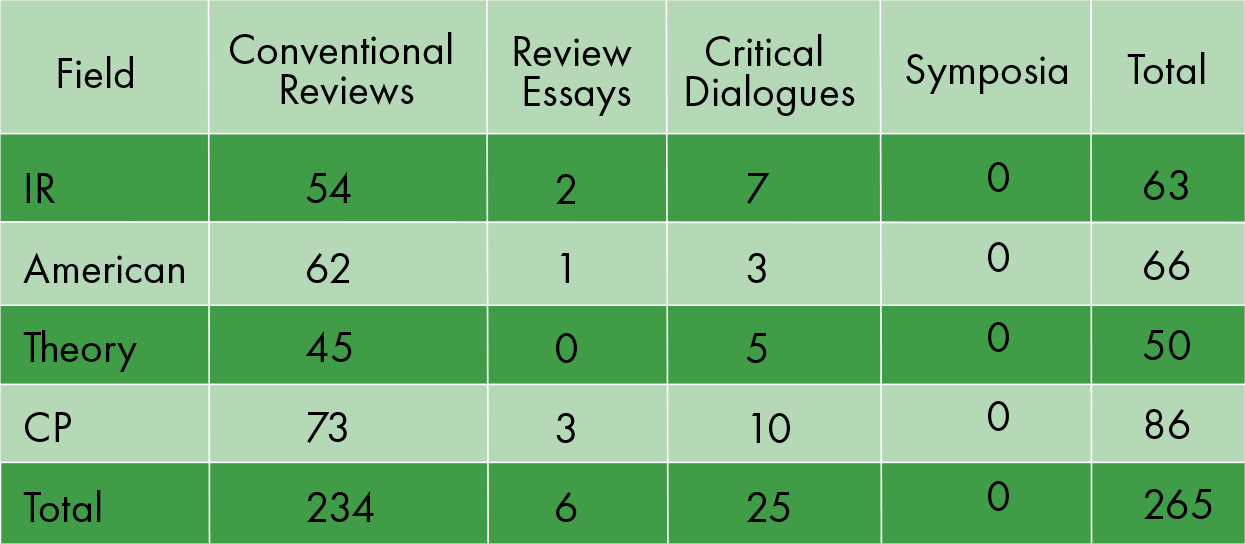
Highlights this past year included two extremely popular Review Essays (Amitav Acharya’s “Before the ‘West’: Recovering the Forgotten Foundations of Global Order,” and Ling S. Chen’s “Getting China’s Political Economy Right: State, Business, and Authoritarian Capitalism”), as well as an important assessment of four books on modern executive power by one of the leading authorities on the American Constitution, Sanford Levinson. Our “Critical Dialogue” section continues to be the one of the best places for scholarly discussion and debate in the discipline. This year, we staged 25 such exchanges, which included those between Stephen Crowley and Timothy Frye on Putin’s Russia; Hélène Landemore and Camila Vergara as well as Sofia Näsström and Jan-Werner Müller on the prospects for democracy in the 21st century; Daniel Agbiboa and Peer Schouten on the roots of violence in Africa; Kevin Mazur and Justin Schon on the war in Syria; Erin Pineda and Paul Passavant on civil disobedience and protest in the United States; James Loxton, Carew Boulding, and Claudio Holzner on political participation in Latin America; Rumela Sen and Isabelle Duyvesteyn on the trajectory of armed rebellion; and Robert Blair and Audrey Comstock on peacekeeping and human rights, as well as many others.
FINAL WORDS
Michael Bernhard and Daniel O’Neill’s stewardship of the journal will end on May 31, 2023. Jennifer Boylan will remain as Managing Editor. Her mastery of the process of managing and producing the journal and indefatigable spirit will make the job of our successors much easier. We owe Jen a debt of gratitude. Her work was essential to the success of the journal.
We have learned a great deal about the discipline substantively and practically. Our overall experience in dealing with our colleagues has been overwhelmingly, but not universally, positive. We begin our sign off by thanking our current staff of editorial assistants who are all pursuing their PhDs at the University of Florida—Stephanie Denardo, Graham Gallagher, Karla Mundim, and Kelly Richardson. We also thank our past editorial assistants who have moved on to new careers— Alec Dinnin, Dragana Svraka, Peter Licari, Marah Schlingensiepen, Nicholas Rudnik, and Saskia van Wees. We also owe a debt of gratitude to Mark Zadrozny, David Mainwaring, Lauren Marra, Jim Ansell, Alyssa Neumann, Molly Sheffer, Andrew Hyde, Linda Lindenfelser, Gavin Swanson, and Gail Naron Chalew at Cambridge University Press who have made the production and distribution of the journal a worry-free and collegial process.
None of this would have been possible without the support of the leadership and publication team at APSA—John Ishiyama, Steven R. Smith, Jon Gurstelle, Madelyn Dewey, and Karima Scott. We are indebted to the Department of Political Science and the College of Liberal Arts and Sciences at the University of Florida led by Dean David Richardson for giving us the time, space, and support to do this. The members of the Editorial Board have been a remarkable and inexhaustible supply of support, encouragement and advice.Footnote 2 Finally, to all those who have submitted manuscripts and wrote reader’s reports and book reviews for the journal, we are humbled by your commitment to the discipline and your excellence as scholars. We learned from all concerned.



